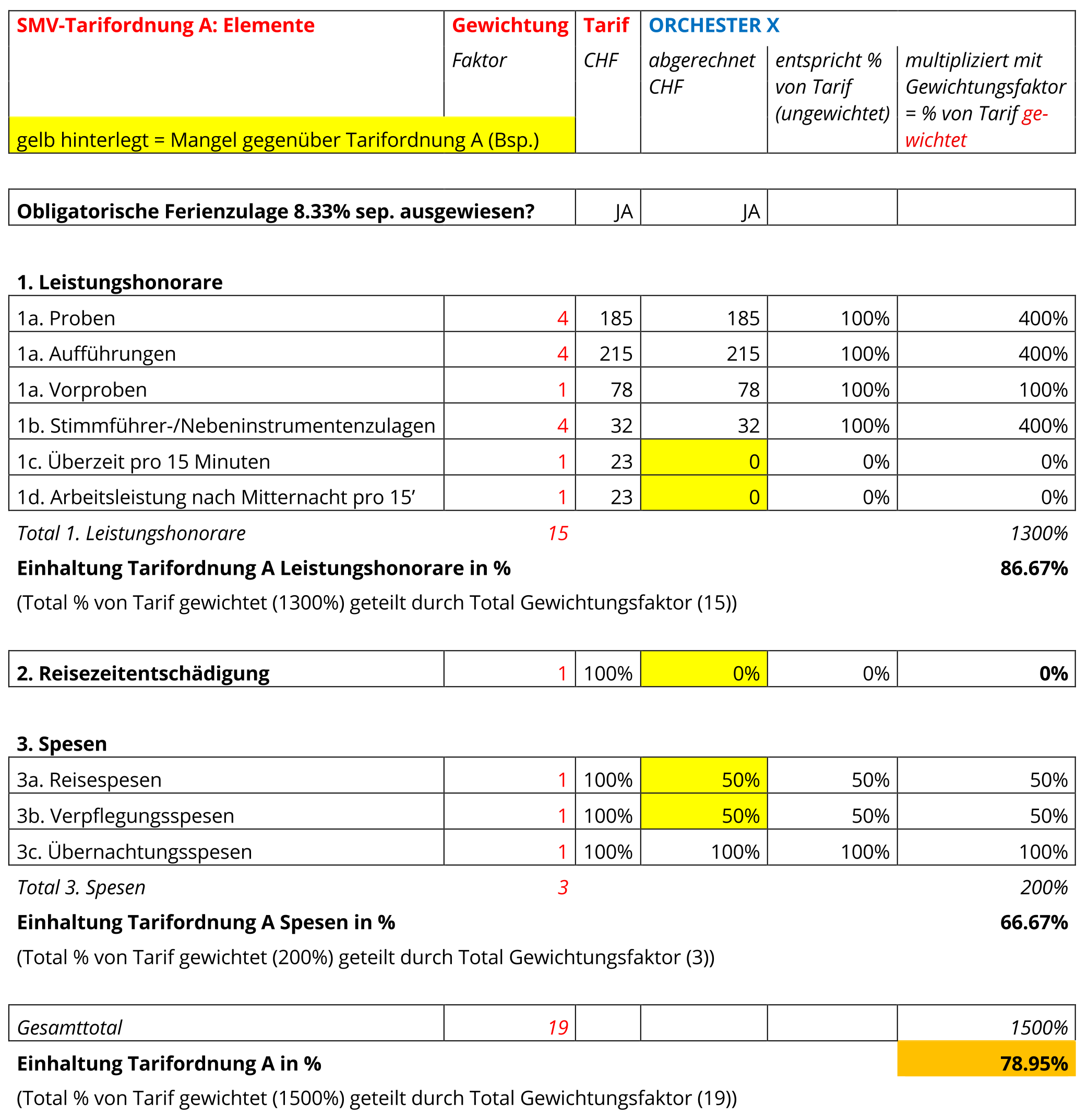Terms of employment for extras/substitutes in professional orchestras in Switzerland
Transparent presentation using the SMV-USDAM tariff traffic lights map
The Swiss orchestra and landscape is very diverse and, in addition to the 13 full-time professional orchestras, includes a multitude of professional part-time/project orchestras and of various kinds, which are important employers for many freelance professional musicians in Switzerland and would not exist without them.
SMV-USDAM has collective labour agreements with the full-time orchestras, which guarantee good working conditions for the permanent orchestra members.
The terms of employment for temporary staff (extra/substitute musicians) in these orchestras are regulated in the collective agreement between SMV-USDAM and the employers’ association orchester.ch.
Unfortunately, this is not the case in many places, and since the pandemic, we have observed a further deterioration in many cases. The willingness to treat professionals in the music sector with the same respect as those in other industries in terms of pay seems to be declining further. There is no other explanation for how it is possible today that orchestras financed by lottery subsidies and well-known sponsors in the most expensive Swiss cities are advertising for professional musicians, offering them CHF 125 for a three-hour rehearsal and CHF 150 for a three-hour concert. No expense allowance, not even the mandatory holiday allowance in accordance with Art. 329ff OR. For highly qualified work by professionals with university degrees, which includes prior individual rehearsal of the works to be played, the purchase and maintenance of sometimes very expensive instruments, and much more.
After all, the federal government also wants to use its 2025-2028 cultural message to ‘guarantee appropriate compensation for cultural workers and improve their working conditions and equal opportunities.’ The National Cultural Dialogue (NKD), which brings together the federal government, cantons and cities, has also presented recommendations on compensation for artists in Switzerland. In it, “the NKD appeals to the collective responsibility of cities/municipalities, cantons and the federal government to strengthen the professionalisation and recognition of the work of cultural workers, on the one hand by complying with, applying and enforcing the present recommendations on the correct remuneration of cultural workers and, on the other hand, by continuing efforts to improve their economic and legal situation.»
Since the beginning of March 2025, the SMV has written to all professional part-time orchestras known to us, asking them to inform us of the rates they apply or to confirm the information we have received from musicians. Some have provided us with this information, others have not, even after the third letter. Others informed us that, for various reasons, they were unwilling to do so or that they rejected our approach. Therefore, the tariff traffic light map currently includes those orchestras that have either provided information themselves or for which we have current data from musicians. Missing orchestras will be added later.
The full-time professional orchestras were also contacted and asked to confirm that they comply with all aspects of the current collective agreement. Firstly, because a tariff traffic light map of Switzerland would be incomplete and unfair to the other orchestras without these most heavily subsidised orchestras, and secondly, because we have been receiving reports of systematic violations of individual elements of the collective agreement for some time now.
Tariff traffic light map
The map shows how extras/substitutes are remunerated in the various orchestras in Switzerland.
A distinction is made between:
- full-time professional orchestras (members of orchester.ch): These orchestras must comply with the collective agreement between orchester.ch and SMV-USDAM. If they do this 100% in all areas, they are coloured green; if not, red. They are indicated by a filled-in circle. View only full-time professional orchestras
- professional part-time orchestras: SMV-USDAM requires these orchestras to comply with the tariff scale A (minimum rates). If the weighted assessment results in 100% or more tariff compliance, they are coloured green; between 75 and 99%, orange; and below 75%, red. They are indicated by a filled-in hash. View only professional part-time orchestras
Weighting for professional part-time orchestras
In recognition of the fact that securing sufficient funding for professional orchestras is no easy task, the most common central elements in the area of performance fees, such as rehearsals and performances, are given much greater weight than less frequently applied elements, such as overtime. Similarly, travel time compensation and all elements in the area of expense allowances are given comparatively low weighting.
Performance fees for rehearsals and performances (tariff scale A, paragraph 1a) as well as the principal/secondary instrument allowances (tariff scale A, paragraph 1b) are weighted fourfold, all other elements of tariff scale A are weighted simply.
Calculation examples (in German)
a) Wenn die obligatorische Ferienzulage separat ausgewiesen ist:

b) Wenn die obligatorische Ferienzulage gem. Art. 329ff OR NICHT separat ausgewiesen ist, wird der Prozentsatz vom ungewichteten Tarif wie folgt berechnet, weil davon ausgegangen werden muss, dass die obligatorische Ferienentschädigung inklusive ist:
abgerechneter Tarif geteilt durch(Tarif gem. Tarifordnung A mal 0.010833)

General information
A + in the icon indicates that the orchestra in question offers benefits that exceed the collective agreement or tariff scale A, e.g. continued payment of wages in the event of illness.
All information comes from the respective orchestras or musicians. The respective source is indicated. All orchestras were asked to confirm or correct the available data. Some took advantage of this opportunity, others did not, even after three invitations.
In the event of incorrect information, we kindly request that the relevant orchestra send us the correct details immediately. The same applies to extras/substitutes who notice discrepancies in the pay slips of the respective orchestras.

